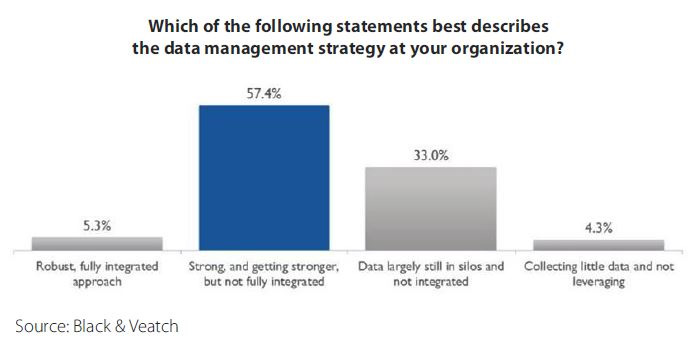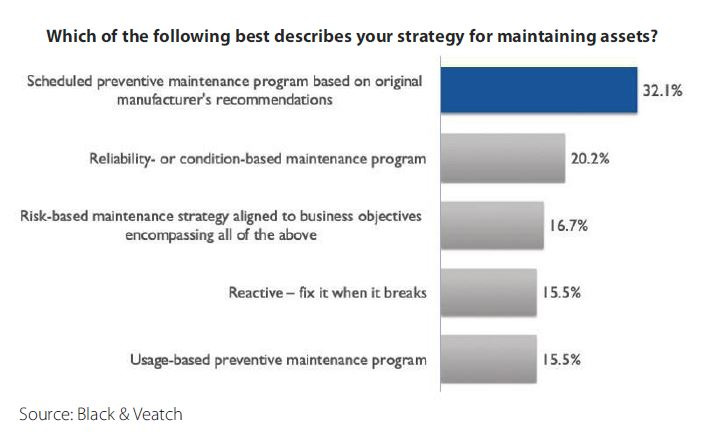Getting Smart About Data — The Key To Water Security
By Paul McRoberts And Joe Zhou
Whether it’s called “digital water” or “smart water,” data is flexing its muscle in industry’s quest for resiliency and asset management.
In the water industry, it’s a fact that cannot be ignored: Data is taking on an increasingly muscular stature in helping utilities validate investments and demonstrate return on them, only after stakeholders fully understand data’s value in ensuring a safe, resilient supply.
That appreciation gets more pressing as the impacts of climate change continue to alter the rules of the game.
Cast not long ago by The Economist as the world’s most valuable resource, data — the core of a smarter infrastructure that could help abate threats to our water supply — gives operators greater oversight of their assets. Digital information, exchanged at staggering rates, is often actionable and predictive, foretelling when to replace or rehab equipment well before the manufacturer’s maintenance manual even suggests it.
Yet against that backdrop, a vexing question lingers: Is data truly being prized sufficiently as something ubiquitous and valuable in this era when technology and tighter budgets should make it ripe for optimization and exploitation? Wireless sensors continue to get better and cheaper by the day, and they can be placed anywhere to measure virtually anything — providing immeasurable precision in detailing everything from consumption and customer engagement to leak detection. All the while, operators are being squeezed to get the most out of equipment and systems that often have surpassed or are nearing their life expectancies, again underscoring the need for data.

Despite all of that promise of what’s now often called “digital water” and “smart water,” the full embrace of data in the interest of driving sustainability, resilience, asset management, and planning isn’t where it could and should be in transforming water systems in much the same way as the Internet of Things (IoT) has revolutionized industries.
According to Black & Veatch’s 2019 Strategic Directions: Water Report survey of hundreds of water industry leaders in North America, a scant 5 percent of respondents reported that their organizations have adopted a robust, fully integrated approach to data management. Nearly six of 10 respondents said their data efforts were getting stronger but weren’t fully integrated. An additional one-third said their organization’s data remained siloed, while more than 4 percent of respondents said they collect little to no data, and whatever digital information they were capturing wasn’t being leveraged.
Asset Management Programs Grab Attention
More than half of the respondents to Black & Veatch’s survey say they have adopted an asset management program (AMP), while a little more than one-third say they’re doing so. But the devil is in those details: Are utilities that claim to have an AMP simply saying it’s merely a Word document that lists how assets are viewed from a financial standpoint? Or is it duly comprehensive, collecting all available information about the history, longevity, and the value of each asset? More about data, less about process and procedure?
Fifty-seven percent of respondents said their data management strategy is strong and getting better, though it’s still not fully integrated, making it difficult to understand what’s occurring collectively across systems. One-third said their data still is siloed and unintegrated; that’s a missed opportunity in presenting a holistic view of the health of systems because silos of data in computer systems don’t always talk to each other.

Without a strategic and integrated plan, fragmented data streams feed what’s tantamount to data “islands” that don’t communicate, inhibiting a more beneficial, broad snapshot of the system. The move to become “insights-driven” puts a premium on data collection and analytics to drive integrated decision-making.
More Data, Less Guesswork Or “Tribal Knowledge”
When it comes to helping decide when to replace assets, nine of every 10 respondents to the Black & Veatch survey say they employ a risk-based approach at different levels. More than 40 percent say they use factors such as the likelihood or consequence of failure to plan investments in new equipment. Twenty-eight percent said they defer to the skill and experiences of operators and technicians, suggesting more of a “tribal knowledge” approach rather than a decision based on data and other technology.
Separately, roughly one-third of respondents scheduled preventive maintenance according to the original manufacturer’s recommendations, or “doing it by the book.” One of every five respondents lean on reliability or condition-based maintenance. Thirty percent basically follow the status quo, reactively just fixing it when it breaks or repairing things based on usage.
Suggested upkeep of assets is based on how they were designed, built, and tested, often in perfect conditions: 70 degrees, 50 percent relative humidity, and a spotless, dust-free environment. Contrast that with pumps, boilers, and other assets laboring in real-world conditions, with data spitting out instantaneous details about how each is behaving. If the performance changes, sensors alert the operator, helping predict failure or the prospect of abuse.
Helping the cause is ASSET360® (atonix.com/asset360), a cloud-based analytics portfolio by Black & Veatch subsidiary Atonix Digital. The platform gives clients a one-stop solution that employs analytics to help do everything from manage risk, plan capital, and monitor system health. As the adage goes, you can’t manage what you don’t measure.
The Time For Data Is Now
Just as industries have embraced the IoT to connect technologies and add value to our daily lives, the “Internet of Water” promises a similar transformation for our water systems through next-generation collection devices and predictive analytics. The internet’s ubiquity and the availability of cheap sensors make possible ever-increasing, cost-efficient gathering of condition and performance data.
With the Internet of Water, which offers the ability to funnel disparate data into a single, meaningful snapshot of the entire water ecosystem, operators can know, predict, and plan around water management at the source, leak detection through the conveyance process, and energy resource management at plants.
From inside the fence to behind the meter, the Internet of Water is pushing data’s potential deeper into organizations, influencing planning, asset management, customer interaction, and operations. Our survey results show more organizations are incorporating digital strategies into their offerings, and the result promises a water ecosystem that’s more responsive, secure, resilient, and abundant.
Many of the headlines about threats to our water supply — from Flint, Michigan, to South Africa’s Cape Town, where residents last year stared down the moment when their water system was predicted to run dry — are strong reminders that the time to future-proof our systems is now.
About The Authors
 Paul McRoberts is president of Atonix Digital, a Black & Veatch software subsidiary. He oversees the development and deployment of the company’s suite of software products powered by the ASSET360 analytics platform. McRoberts brings both rich software development experience and an in-depth understanding of how deep data exploration is helping transform businesses through greater insight and intelligence.
Paul McRoberts is president of Atonix Digital, a Black & Veatch software subsidiary. He oversees the development and deployment of the company’s suite of software products powered by the ASSET360 analytics platform. McRoberts brings both rich software development experience and an in-depth understanding of how deep data exploration is helping transform businesses through greater insight and intelligence.
 Joe Zhou is managing director at Black & Veatch management consulting, where he leads the asset management and analytics practice to provide innovative and insightful consulting services to asset-intensive industries, such as power, oil and gas, and water. Zhou has more than 20 years’ experience enabling business transformations through the use of digital technologies and leading business practices.
Joe Zhou is managing director at Black & Veatch management consulting, where he leads the asset management and analytics practice to provide innovative and insightful consulting services to asset-intensive industries, such as power, oil and gas, and water. Zhou has more than 20 years’ experience enabling business transformations through the use of digital technologies and leading business practices.
